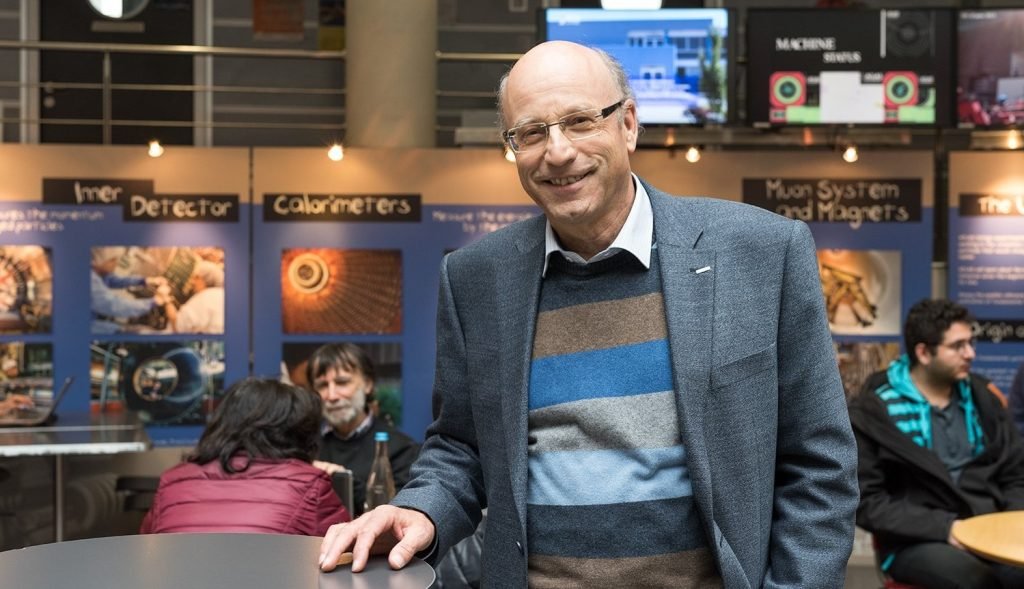
“Finding the Higgs boson at Cern’s Large Hadron Collider (LHC) was all about the power of long-term research and collaboration in large science projects between large numbers of top physicists from many countries,” says Peter Jenni.
He’s an experimental physicist at Cern (the European Organisation for Nuclear Research) in Switzerland and the University of Freiburg (Germany), and he flew out from Switzerland to give a talk at the Nelson Mandela University on the long journey to this discovery at the 2022 edition of the African School of Fundamental Physics and Applications (ASP2022) from 28 November to 9 December 2022. It was attended by more than 100 of Africa’s top final-year and postgraduate physics, mathematics, engineering and computer science students, including 60 from South Africa. A further 100 African students throughout the continent participated online.
“It was an absolute highlight in July 2012 when we were able to announce the discovery of the long-awaited Higgs boson particle by the Atlas and CMS teams,” says Jenni.
He was the project leader of the Atlas experiment at the Cern LHC until 2009 and is an ongoing collaborator. Atlas is the largest-volume, multi-purpose detector ever constructed at a particle collider. It sits about 100m underground in a large cavern at Cern.
Atlas and CMS are the two general-purpose detectors at the LHC that look for new particles such as the Higgs boson. They were named in the citation for the 2013 Nobel prize in physics, awarded to François Englert and Peter Higgs.
Jenni was one of the drivers in establishing SA-Cern, a 14-year collaboration between Cern and the SA Consortium of Universities and Research Institutions. Established in 2008, the SA-Cern collaboration has effectively created a distributed Cern partner research laboratory across South Africa. South African scientists collaborate with Cern and visit and work there.
Jenni says: “It is imperative that young people in Africa are motivated to learn physics and be part of big science projects, and for fellowships to be made available to top African physics students to grow the international research pipeline.”
Particles could be a unique portal
Jenni explains that the Higgs boson particle is fundamental to the understanding of the physical universe and nature in its smallest components. Such is its importance that the media started referring to it as the “God particle”, but Jenni does not like this term because he thinks this is about science, not religion.
Scientists believe it is the particle that gives all matter its mass and is a manifestation that the Higgs field exists. This could be a unique portal to finding signs of dark matter, thought to account for about 85% of the matter in the universe and making up most of the mass of galaxies and galaxy clusters.
“If we understand dark matter it would intellectually bring us a giant step forward, as we don’t really understand the evolution of the universe,” Jenni says.
Developing the experimental programme with the unique high-energy LHC and the sophisticated detectors that were built and operated by worldwide collaborators in the Atlas team “was an incredible scientific, technological and human adventure spanning more than three decades,” says Jenni.
Worldwide collaboration of more than 3 000 physicists
The Higgs boson discovery came two decades after Atlas started in 1992 and included a global collaboration for more than 3 000 physicists from 183 institutions in 38 countries, including South Africa and some other African countries.
It took a huge amount of time to get to the first collisions in 2009, as the experiments at the LHC are the highest collision energies ever achieved in a laboratory.
“We gained experience from numerous smaller experiments over decades to build something of the unique size and complexity of the LHC, and develop the very sophisticated software, analysis tools and methods that were required for the discovery,” Jenni says.
In the course of these large science projects, apart from advancing human understanding about what makes life so special, scientists develop useful technology for the world. The understanding of gravity, for example, was key to the development of the GPS, and the development of the world wide web is attributed to scientists working on colliders who needed to exchange information, more than 30 years ago.
What makes life so special
It was the pursuit of understanding what makes life so special that attracted Jenni to physics. “In my journey as a scientist I was curious about how nature in its smallest entities works, what the elementary building blocks are and how they interact with each other. I wanted to advance knowledge on fundamental physics in a global way.
“Being Swiss-born, I had the privilege of being in the home base of Cern, and as a student, I spent a couple of months at Cern and got hooked.”
He got his doctorate at the Swiss Federal Institute of Technology in Zürich in 1976, worked as a research associate at the Stanford Linear Accelerator Centre in the US and then joined Cern full-time in 1980. He says it’s stimulating to work with colleagues from every part of the world and do experiments at the forefront of collision energies.
“As an experimentalist, I thrive on building and operating increasingly sophisticated equipment and doing sophisticated experiments, which I was able to do at Cern, and this developed into managing others in the Atlas project.”
Jenni was central to collaborative experimental work leading to the discoveries of the W and Z bosons in the 1980s and the Higgs boson in 2012. Through the collaborations, he has co-authored more than 1 000 publications in top scientific journals.
A decade later
Ten years on, Jenni sits on physics advisory committees all over the world and consults for the Atlas and Cern leadership. He has worked with the director general of Cern, Fabiola Gianotti, for many years. She worked with Jenni when she was a PhD student. He says he gets enormous pleasure from witnessing the growth of students he has supervised or for whom he has played a role in their careers.
Much has been learned about the Higgs particle. “It could be a key to new physics beyond the Standard Model of physics, which is not complete because while it certainly describes what happens in a nuclear reaction in a star, it does not explain galaxy formation, as it has no explanation for dark matter,” says Jenni.
“We don’t know what dark matter is. We assume it is built out of particles, and so there are a whole series of experiments looking for it, including the pursuit to measure the Higgs particle with far more precision. For some specific measurements, we would need to build a new collider, but in the meantime, the LHC will be running until 2040, and we are upgrading the detector to get more data and more precise data. Higher energy colliding could produce dark matter particles, or even with the LHC, but we haven’t had enough collisions to scrutinise this conclusively.
“With colliders, we are also looking for free quarks (elementary particles), which nobody has seen, and it will be a fantastic discovery if we find them, as it would mean we can see a particle that has a fractional charge and that can travel through space. The quarks we know about are never free; they have a one-third or two-thirds charge, and either has a positive or negative charge, and they recombine to form compositive particles/hadrons, such as protons and neutrons.”
Beyond the LHC
Hadron colliders and their detectors are crucial to the success of the next step into the unknown. A technical and financial feasibility study for a 100km circular collider at Cern with a collision energy of at least 100 TeV is now underway, as compared to 14 TeV with the LHC, but once again this takes time as there are tremendous technical challenges.
“In the meantime, we’ll continue analysing more data from the LHC,” says Jenni. “Both these activities are now motivating new generations of students and postdocs, which gives me great pleasure. The current healthy mix of wealthy and less-wealthy countries was established in the two collaborations, placing value clearly not only on material contributions but also on intellectual ones.”
The post The long journey to the Higgs boson and beyond: the power of collaboration appeared first on The Mail & Guardian.


